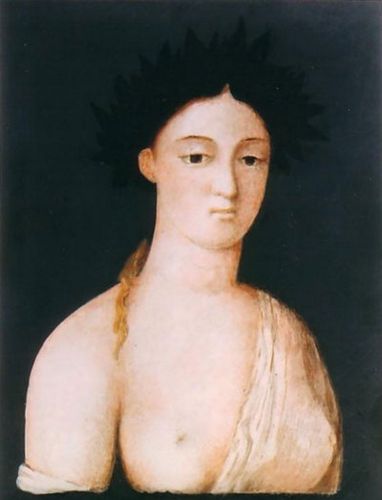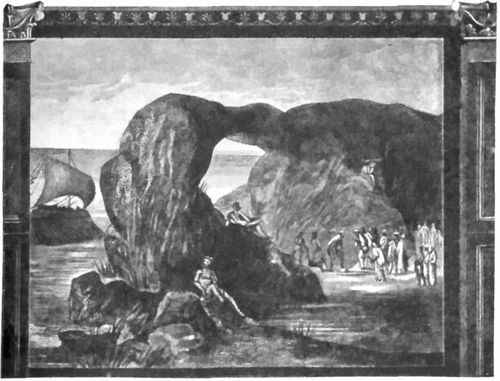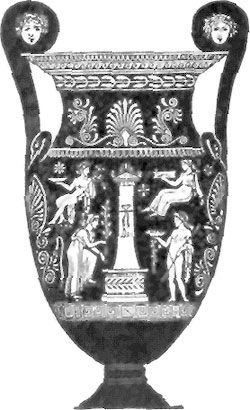








Books Recommended: Baumeister, Denkmäler des klassischen Altertums—article "Malerei;" Birch, History of Ancient Pottery; Brunn, Geschichte der griechischen Künstler; Collignon, Mythologie figurée de la Grèce; Collignon, Manuel d'Archaeologie Grecque; Cros et Henry, L'Encaustique et les autres procédés de Peinture chez les Anciens; Girard, La Peinture Antique; Murray, Handbook of Greek Archæology; Overbeck, Antiken Schriftquellen zur geschichte der bildenen Kunste bie den Griechen; Perrot and Chipiez, History of Art in Greece; Woerman, Die Landschaft in der Kunst der antiken Volker; see also books on Etruscan and Roman painting.
GREECE AND THE GREEKS: The origin of the Greek race is not positively known. It is reasonably supposed that the early settlers in Greece came from the region of Asia Minor, either across the Hellespont or the sea, and populated the Greek islands and the mainland. When this was done has been matter of much conjecture. The early history is lost, but art remains show that in the period before Homer the Greeks were an established race with habits and customs distinctly individual. Egyptian and Asiatic influences are apparent in their art at this early time, but there is, nevertheless, the mark of a race peculiarly apart from all the races of the older world.
The development of the Greek people was probably helped by favorable climate and soil, by commerce and conquest, by republican institutions and political faith, by freedom of mind and of body; but all these together are not sufficient to account for the keenness of intellect, the purity of taste, and the skill in accomplishment which showed in every branch of Greek life. The cause lies deeper in the fundamental make-up of the Greek mind, and its eternal aspiration toward mental, moral, and physical ideals. Perfect mind, perfect body, perfect conduct in this world were sought-for ideals. The Greeks aspired to completeness. The course of education and race development trained them physically as athletes and warriors, mentally as philosophers, law-makers, poets, artists, morally as heroes whose lives and actions emulated those of the gods, and were almost perfect for this world.
ART MOTIVES: Neither the monarchy nor the priesthood commanded the services of the artist in Greece, as in Assyria and Egypt. There was no monarch in an oriental sense, and the chosen leaders of the Greeks never, until the late days, arrogated art to themselves. It was something for all the people.
In religion there was a pantheon of gods established and worshipped from the earliest ages, but these gods were more like epitomes of Greek ideals than spiritual beings. They were the personified virtues of the Greeks, exemplars of perfect living; and in worshipping them the Greek was really worshipping order, conduct, repose, dignity, perfect life. The gods and heroes, as types of moral and physical qualities, were continually represented in an allegorical or legendary manner. Athene represented noble warfare, Zeus was majestic dignity and power, Aphrodite love, Phœbus song, Niké triumph, and all the lesser gods, nymphs, and fauns stood for beauties of nature or of life. The great bulk of Greek architecture, sculpture, and painting was put forth to honor these gods or heroes, and by so doing the artist repeated the national ideals and honored himself. The first motive of Greek art, then, was to praise Hellas and the Hellenic view of life. In part it was a religious motive, but with little of that spiritual significance and belief which ruled in Egypt, and later on in Italy.
 FIG. 11.—ATTIC GRAVE PAINTING.
FIG. 11.—ATTIC GRAVE PAINTING.A second and ever-present motive in Greek painting was decoration. This appears in the tomb pottery of the earliest ages, and was carried on down to the latest times. Vase painting, wall painting, tablet and sculpture painting were all done with a decorative motive in view. Even the easel or panel pictures had some decorative effect about them, though they were primarily intended to convey ideas other than those of form and color.
SUBJECTS AND METHODS: The gods and heroes, their lives and adventures, formed the early subjects of Greek painting. Certain themes taken from the "Iliad" and the "Odyssey" were as frequently shown as, afterward, the Annunciations in Italian painting. The traditional subjects, the Centaurs and Lapiths, the Amazon war, Theseus and Ariadne, Perseus and Andromeda, were frequently depicted. Humanity and actual Greek life came in for its share. Single figures, still-life, genre, caricature, all were shown, and as painting neared the Alexandrian age a semi-realistic portraiture came into vogue.
The materials employed by the Greeks and their methods of work are somewhat difficult to ascertain, because there are few Greek pictures, except those on the vases, left to us. From the confusing accounts of the ancient writers, the vases, some Greek slabs in Italy, and the Roman paintings imitative of the Greek, we may gain a general idea. The early Greek work was largely devoted to pottery and tomb decoration, in which much in manner and method was borrowed from Asia, Phœnicia, and Egypt. Later on, painting appeared in flat outline on stone or terra-cotta slabs, sometimes representing processional scenes, as in Egypt, and doubtless done in a hybrid fresco-work similar to the Egyptian method. Wall paintings were done in fresco and distemper, probably upon the walls themselves, and also upon panels afterward let into the wall. Encaustic painting (color mixed with wax upon the panel and fused with a hot spatula) came in with the Sikyonian school. It is possible that the oil medium and canvas were known, but not probable that either was ever used extensively.
There is no doubt about the Greeks being expert draughtsmen, though this does not appear until late in history. They knew the outlines well, and drew them with force and grace. That they modelled in strong relief is more questionable. Light-and-shade was certainly employed in the figure, but not in any modern way. Perspective in both figures and landscape was used; but the landscape was at first symbolic and rarely got beyond a decorative background for the figure. Greek composition we know little about, but may infer that it was largely a series of balances, a symmetrical adjustment of objects to fill a given space with not very much freedom allowed to the artist. In atmosphere, sunlight, color, and those peculiarly sensuous charms that belong to painting, there is no reason to believe that the Greeks approached the moderns. Their interest was chiefly centred in the human figure. Landscape, with its many beauties, was reserved for modern hands to disclose. Color was used in abundance, without doubt, but it was probably limited to the leading hues, with little of that refinement or delicacy known in painting to-day.
ART HISTORY: For the history of Greek painting we have to rely upon the words of Aristotle, Plutarch, Pliny, Quintilian, Lucian, Cicero, Pausanias. Their accounts appear to be partly substantiated by the vase paintings, and such few slabs and Roman frescos as remain to us. There is no consecutive narrative. The story of painting originating from a girl seeing the wall-silhouette of her lover and filling it in with color, and the conjecture of painting having developed from embroidery work, have neither of them a foundation in fact. The earliest settlers of Greece probably learned painting from the Phœnicians, and employed it, after the Egyptian, Assyrian, and Phœnician manner, on pottery, terra-cotta slabs, and rude sculpture. It developed slower than sculpture perhaps; but were there anything of importance left to judge from, we should probably find that it developed in much the same manner as sculpture. Down to 500 B.C. there was little more than outline filled in with flat monochromatic paint and with a decorative effect similar, perhaps, to that of the vase paintings. After that date come the more important names of artists mentioned by the ancient writers. It is difficult to assign these artists to certain periods or schools, owing to the insufficient knowledge we have about them. The following classifications and assignments may, therefore, in some instances, be questioned.
 FIG. 12.—MUSE OF CORTONA, CORTONA MUSEUM.
FIG. 12.—MUSE OF CORTONA, CORTONA MUSEUM.OLDER ATTIC SCHOOL: The first painter of rank was Polygnotus (fl. 475-455 B.C.), sometimes called the founder of Greek painting, because perhaps he was one of the first important painters in Greece proper. He seems to have been a good outline draughtsman, producing figures in profile, with little attempt at relief, perspective, or light-and-shade. His colors were local tones, but probably more like nature and more varied than anything in Egyptian painting. Landscapes, buildings, and the like, were given in a symbolic manner. Portraiture was a generalization, and in figure compositions the names of the principal characters were written near them for purposes of identification. The most important works of Polygnotus were the wall paintings for the Assembly Room of the Knidians at Delphi. The subjects related to the Trojan War and the adventures of Ulysses.
Opposed to this flat, unrelieved style was the work of a follower, Agatharchos of Samos (fl. end of fifth century B.C.). He was a scene-painter, and by the necessities of his craft was led toward nature. Stage effect required a study of perspective, variation of light, and a knowledge of the laws of optics. The slight outline drawing of his predecessor was probably superseded by effective masses to create illusion. This was a distinct advance toward nature. Apollodorus (fl. end of fifth century B.C.) applied the principles of Agatharchos to figures. According to Plutarch, he was the first to discover variation in the shade of colors, and, according to Pliny, the first master to paint objects as they appeared in nature. He had the title of skiagraphos (shadow-painter), and possibly gave a semi-natural background with perspective. This was an improvement, but not a perfection. It is not likely that the backgrounds were other than conventional settings for the figure. Even these were not at once accepted by the painters of the period, but were turned to profit in the hands of the followers.
After the Peloponnesian Wars the art of painting seems to have flourished elsewhere than in Athens, owing to the Athenian loss of supremacy. Other schools sprang up in various districts, and one to call for considerable mention by the ancient writers was the
IONIAN SCHOOL, which in reality had existed from the sixth century. The painters of this school advanced upon the work of Apollodorus as regards realistic effect. Zeuxis, whose fame was at its height during the Peloponnesian Wars, seems to have regarded art as a matter of illusion, if one may judge by the stories told of his work. The tale of his painting a bunch of grapes so like reality that the birds came to peck at them proves either that the painter's motive was deception, or that the narrator of the tale picked out the deceptive part of his picture for admiration. He painted many subjects, like Helen, Penelope, and many genre pieces on panel. Quintilian says he originated light-and-shade, an achievement credited by Plutarch to Apollodorus. It is probable that he advanced light-and-shade.
In illusion he seems to have been outdone by a rival, Parrhasios of Ephesus. Zeuxis deceived the birds with painted grapes, but Parrhasios deceived Zeuxis with a painted curtain. There must have been knowledge of color, modelling, and relief to have produced such an illusion, but the aim was petty and unworthy of the skill. There was evidently an advance technically, but some decline in the true spirit of art. Parrhasios finally suffered defeat at the hands of Timanthes of Kythnos, by a Contest between Ajax and Ulysses for the Arms of Achilles. Timanthes's famous work was the Sacrifice of Iphigenia, of which there is a supposed Pompeian copy.
SIKYONIAN SCHOOL: This school seems to have sprung up after the Peloponnesian Wars, and was perhaps founded by Eupompos, a contemporary of Parrhasios. His pupil Pamphilos brought the school to maturity. He apparently reacted from the deception motive of Zeuxis and Parrhasios, and taught academic methods of drawing, composing, and painting. He was also credited with bringing into use the encaustic method of painting, though it was probably known before his time. His pupil, Pausias, possessed some freedom of creation in genre and still-life subjects. Pliny says he had great technical skill, as shown in the foreshortening of a black ox by variations of the black tones, and he obtained some fame by a figure of Methè (Intoxication) drinking from a glass, the face being seen through the glass. Again the motives seem trifling, but again advancing technical power is shown.

THEBAN-ATTIC SCHOOL: This was the fourth school of Greek painting. Nikomachus (fl. about 360 B.C.), a facile painter, was at its head. His pupil, Aristides, painted pathetic scenes, and was perhaps as remarkable for teaching art to the celebrated Euphranor (fl. 360 B.C.) as for his own productions. Euphranor had great versatility in the arts, and in painting was renowned for his pictures of the Olympian gods at Athens. His successor, Nikias (fl. 340-300 B.C.), was a contemporary of Praxiteles, the sculptor, and was possibly influenced by him in the painting of female figures. He was a technician of ability in composition, light-and-shade, and relief, and was praised for the roundness of his figures. He also did some tinting of sculpture, and is said to have tinted some of the works of Praxiteles.
LATE PAINTERS: Contemporary with and following these last-named artists were some celebrated painters who really belong to the beginning of the Hellenistic Period (323 B.C.). At their head wasApelles, the painter of Philip and Alexander, and the climax of Greek painting. He painted many gods, heroes, and allegories, with much "gracefulness," as Pliny puts it. The Italian Botticelli, seventeen hundred years after him, tried to reproduce his celebrated Calumny, from Lucian's description of it. His chief works were his Aphrodite Anadyomene, carried to Rome by Augustus, and the portrait of Alexander with the Thunder-bolt. He was undoubtedly a superior man technically. Protogenes rivalled him, if we are to believe Petronius, by the foam on a dog's mouth and the wonder in the eye of a startled pheasant.Aëtion, the painter of Alexander's Marriage to Roxana, was not able to turn the aim of painting from this deceptive illusion. After Alexander, painting passed still further into the imitative and the theatrical, and when not grandiloquent was infinitely little over cobbler-shops and huckster-stalls. Landscape for purposes of decorative composition, and floor painting, done in mosaic, came in during the time of the Diadochi. There were no great names in the latter days, and such painters as still flourished passed on to Rome, there to produce copies of the works of their predecessors.
It is hard to reconcile the unworthy motive attributed to Greek painting by the ancient writers with the high aim of Greek sculpture. It is easier to think (and it is more probable) that the writers knew very little about art, and that they missed the spirit of Greek painting in admiring its insignificant details. That painting technically was at a high point of perfection as regards the figure, even the imitative Roman works indicate, and it can hardly be doubted that in spirit it was at one time equally strong.
EXTANT REMAINS: There are few wall or panel pictures of Greek times in existence. Four slabs of stone in the Naples Museum, with red outline drawings of Theseus, Silenos, and some figures with masks, are probably Greek work from which the color has scaled. A number of Roman copies of Greek frescos and mosaics are in the Vatican, Capitoline, and Naples Museums. All these pieces show an imitation of late Hellenistic art—not the best period of Greek development.
 Fig. 14.—AMPHORE, LOWER ITALY.
Fig. 14.—AMPHORE, LOWER ITALY.THE VASES: The history of Greek painting in its remains is traced with some accuracy in the decorative figures upon the vases. The first ware—dating before the seventh century B.C.—seems free from oriental influences in its designs. The vase is reddish, the decoration is in tiers, bands, or zig-zags, usually in black or brown, without the human figure. The second kind of ware dates from about the middle of the seventh century. It shows meander, wave, and other designs, and is called the "geometrical" style. Later on animals, rosettes, and vegetation appear that show Assyrian influence. The decoration is profuse and the rude human figure subordinate to it. The design is in black or dark-brown, on a cream-colored slip. The third kind of ware is the archaic or "strong" style. It dates from 500 B.C. to the Peloponnesian Wars, and is marked by black figures upon a yellow or red ground. White and purple are also used to define flesh, hair, and white objects. The figure is stiff, the action awkward, the composition is freer than before, but still conventional. The subjects are the gods, demi-gods, and heroes in scenes from their lives and adventures. The fourth kind of ware dates down into the Hellenistic age and shows red figures surrounded by a black ground. The figure, the drawing, the composition are better than at any other period and suggest a high excellence in other forms of Greek painting. After Alexander, vase painting seems to have shared the fate of wall and panel painting. There was a striving for effect, with ornateness and extravagance, and finally the art passed out entirely.
There was an establishment founded in Southern Italy which imitated the Greek and produced the Apulian ware, but the Romans gave little encouragement to vase painting, and about 65 B.C. it disappeared. Almost all the museums of the world have collections of Greek vases. The British, Berlin, and Paris collections are perhaps as complete as any.